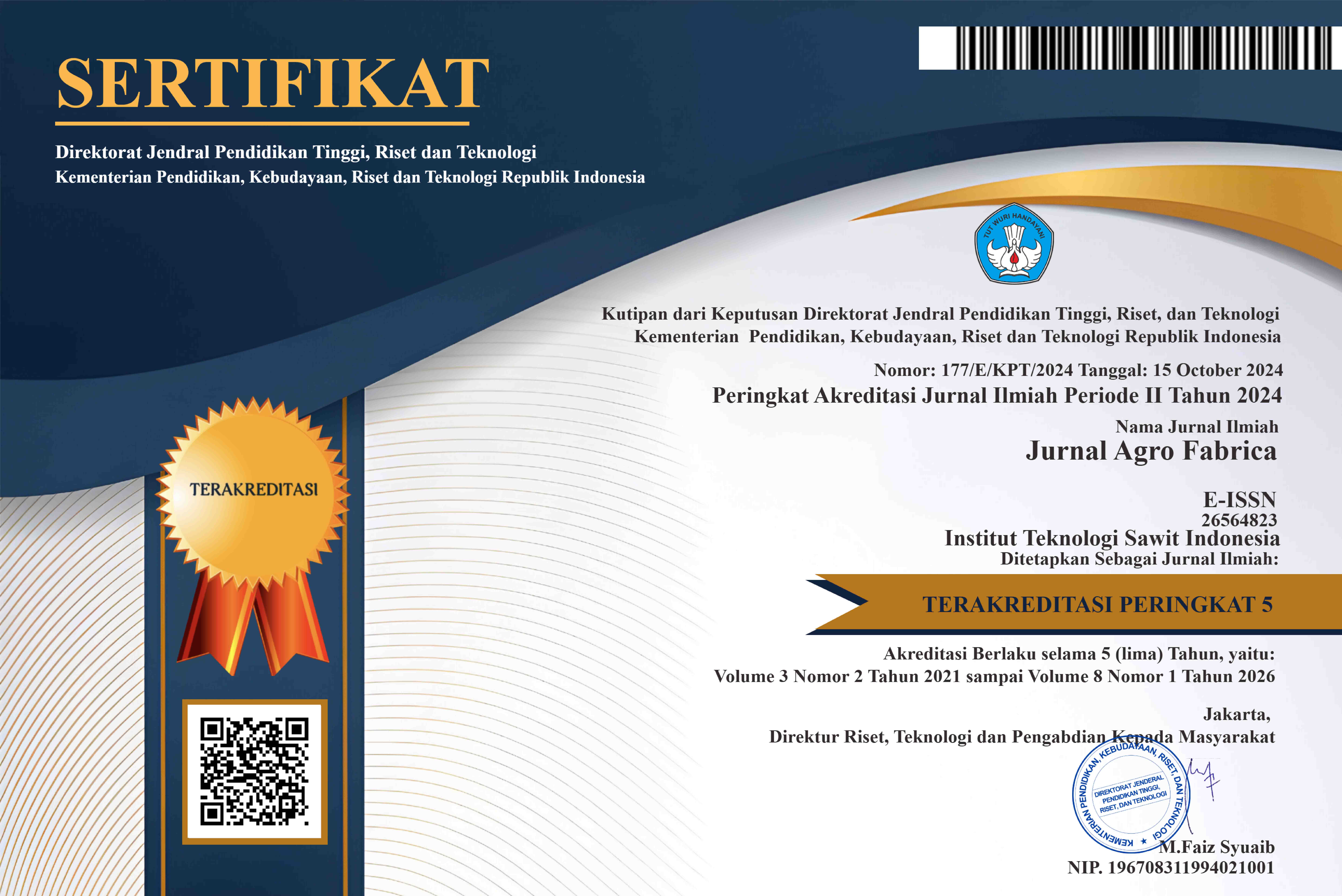POTENSI LIMBAH PADAT KELAPA SAWIT: PELEPAH KELAPA SAWIT DAN TANDAN KOSONG KELAPA SAWIT SEBAGAI BAHAN BAKU BIOETANOL
DOI:
https://doi.org/10.47199/jaf.v3i2.122Keywords:
Oil Palm Empty Fruit Bunches (TKKS), Oil Palm Midribs (PKS) Bioethanol, Bioethanol, Cellulose, FermentationAbstract
The global oil energy crisis is caused by the imbalance between consumption and production of petroleum. In
order to compensate for this imbalance, the conversion of organic waste and biomass into fuel is carried out
appropriately and quickly. This review article aims to determine the potential for solid waste from oil palm,
Oil Palm Empty Bunches (TKKS) and Palm Oil Palm Ribs (PKS) as raw materials for making bioethanol. The
production process of ethanol from palm oil solid waste is carried out starting from lignocellulosic
pretreatment using alkaline and oxidation methods, with the highest results getting a decrease in lignin
content in the EFB substrate from 35.51% to 9.47% or a decrease of 73.33%, while cellulose and
hemicellulose content increased by 69% and 20.68% respectively, then the hydrolysis process with acid and
enzyme catalysts with the highest yield obtained glucose levels of 60.02%, followed by a fermentation process
using Saccharomyces Cerevisiae with the highest yield of ethanol content of 7.93%. Utilization of empty oil
palm fruit bunches (TKKS) and oil palm midribs (PKS) as raw materials for the manufacture of bioethanol
has enormous potential.
Downloads
References
Ahmad, A., Amriz,I., Nabilah. 2020. Produksi Bioetanol Generasi Kedua dari Pelepah Kelapa Sawit dengan Variasi Pretreatment H2SO4 dan Waktu Fermentasi Journal of Bioprocess, Chemical, and Environmental Engineering Vol 1 No 1 (2020).
Aiman, S. 2014.Perkembangan Teknologi dan Tantangan dalam Riset Bioetanol di Indonesia. JKTI, 108-117.
A.T.W.M. Hendriks, G. Zeeman. 2009. Pretreatments To Enhance The Digestibility Of Lignocellulosic Biomass. Wageningen University. Netherlands. Bioresource Technology. 100 : 10-18.
Bajaj, A., Lohan, P., Jha, P.N., dan Mehrotra, R. 2010. Biodiesel production through lipase catalyzed transesterification: An overview. Journal of Molecular Catalysis B: Enzymatic, 62(1), 9–14.
Chandel, A. K., Chan, ES., Rudravaram, R., Narasu, M. L., Rao, L. V., & Ravindra, P. 2007. Economics and environmental impact of bioethanol production technologies: an appraisal. Biotechnology and Molecular Biology Review, 2(1), 014-032.
Costello. R., and Chum. H., 2000. Biomass Bioenergy and Carbon Management, In “Bioenergy „98: Expanding Bioenergy Partnerships” (D. Wichert. Ed.). Omnipress. Madison. WI., p.11- 17.
Dashtban, M., Schraft, H., Qin, W. 2009. FungalBioconversion of Lignocellulosic Residue: Opportunities & Perspectives. Int. J. Biol.Sci., 578-595.
Desroir, Norman. 1988. Unit Processing Organic Synthesis. (New York McGrawHill Book Company).
Dewi, S.R., B.D. Argo, dan N. Ulya. 2018. Kandungan flavonoid dan aktivitas antioksidan ekstrak Pleurotus ostreatus. Jurnal Rona Teknik Pertanian. Vol 11(1): 1–10.
Duff, S. J. B., & Murray, W. D. 1996. Bioconversion of Forest Product Industry Waste Cellulosic to Fuel Ethanol: A Review. Bioresource Technology, 55, 1-33.
Eka, P., dan Halim, A. 2009. Pembuatan Bioetanol dari Nira Siwalan Secara Fermentasi Fase Cair Menggunakan Fermipan. Seminar Tugas Akhir S1 Teknik Kimia UNDIP 2009.
Gírio, F. M., Carvalheiro, F., Duarte, L. C., & Bogel-Łukasi, R. 2012. Deconstruction of the Hemicellulose Fraction from Lignocellulosic Materials into Simple Sugars. Berlin Heidelberg: Springer-Verlag.
Hanim, S. S., Noor, M.A.M., Rosma, A., 2010. Effect of autohydrolysis and enzymatic treatment on oil palm (Elaeis guineensis Jacq.) frond fibers for xylose and xylooligosaccharides production, Bioresource Technol., Article in Press doi:10.1016/j.biortech.2010.08.017.
Honsono, N. 2012. Analisis Lifecycle Bioetanol Berbasis Singkong dan Tandan Kosong Kelapa Sawit di Indonesia.Skripsi. Fakultas Teknik. Universitas Indonesia.
Kulkarni, M.G. dan Dalai, A. K. 2006. Waste Cooking Oil s An Economical Source for Biodiesel: A Review. Industrial & Engineering Chemistry Research, 45(9), 2901–2913.
Kunaepah, U. 2009. Pengaruh Lama Fermentasi dan Konsentrasi Glukosa terhadap aktivitas antibakteri, polifenol, Total dan Mutu Kimia Kefir Susu Kacang Merah, Jurnal Gizi Pangan. Vol II, Edisi 1.
Lynd, L. R., Weimer, P. J., Zyl, M. H. V., & Pretorius, I. S. 2002. Microbial Cellulose Utilization: Fundamentals and Biotechnology. Microbiology and Molecular Biology Reviews, 66(3), 506–577.
Muin R, Lestari D and Sari T W. 2014. Jurnal Teknik Kimia. 20(4) 1-6.
Perez, J., Minoz-Dorado, J., Rubia, T., Martinez, J. 2002. Biodegradation and biological treatments of cellulose, hemicellulose and lignin. Int’l Microbiol. (5), 51-63.
Prescott, S. G dan C. G. Said. 1959. Industrial Microbiology . (New York McGraw-Hill Book Company).
Rilek, Hidayat, dan Sugiarto. 2017. Hidrolisis Lignoselulosa Hasil Pretreatment Pelepah Sawit (Elaeis guineensis Jacq) menggunakan H2SO4 pada Produksi Bioetanol] Jurnal Teknologi dan Manajemen Agroindustri, 6(2): 76-82 (2017).
Sarwono, triwahyuni, aristiawan, kurniawan, anindyawati. 2014. Konversi Selulosa Tandan Kosong Sawit menjadi etanol (TKS), Jurnal Selulosa, Vol. 4, No. 1, Juni 2014 : 1 – 6.
Sheil, D., Casson, A., Meijaard, E., Van Noordwijk, M., Gaskell, J., Groves, J.S., Wertz, K., Kanninem, M. 2009. The impacts and opportunities of oil palm in Southeast Asia, CIFOR, Bogor, Indonesia. p. 6.
Sinaga, C. 2012. Analisis Respon Masyarakat Terhadap Rencana Kenaikan Harga Bbm Jenis Premium (Kasus: Pengendara Mobil Pribadi Di Bogor). Skripsi.Departemen Ilmu Ekonomi Fakultas Ekonomi dan Manajemen Institut Pertanian Bogor.
Smith, A. M. 2010. Prospect for Increasing Starch and Sucrose Yields forBioethanol Production.The Plant Journal. 54:546-558. Subekti, H. 2006. Produksi Bioetanol dari Hidrolisis Fraksi Selulosa Tongkol Jagung oleh Saccharomyces Cerevisiae.Skripsi.Institut Pertanian Bogor. Bogor.
Sukowati, A., Sutikno dan Rizal, S. 2014. Produksi bioetanol dari kulit pisang melalui hidrolisis asam sulfat.Jurnal Teknologi dan Industri Hasil Pertanian. 19(3): 274-288.
Sun, Y., Cheng, J. 2004. Hydrolysis of Lignocellulosic Materials for Ethanol Production: A Review. Bioresource.Technol., 83, 1-11
Suwono, A. 2004. Indonesia‟s Potential Contribution of Biomass in Sustainable Energy Development.Conference Proceeding of the 10th APCCHE Congress. the Asia Pacific Confederation of Chemical Engineering, Kitakyushu Oct. 17-21. Japan
Yunus, R., Salleh, S.F., Abdullah, N. And Biak, D.R.A. 2010. Effect of ultrasonic pretreatment on low temperature acid hydrolysis of oil palm empty fruit bunch, Bioresource Technol., 101(24), 9792-9796.
Yu, Z., Jameel, H., Chang, H. M., Park, S. 2012. A Study in Lignin Inhibition for Enzymatic Hydrolysis of Woody Biomass.Proceedings of 12AIChE Annual Meeting, February11, 2012, Pittsburgh,PA, USA.
Downloads
Published
How to Cite
Issue
Section
License
Copyright (c) 2023 Jurnal Agro Fabrica

This work is licensed under a Creative Commons Attribution 4.0 International License.




















